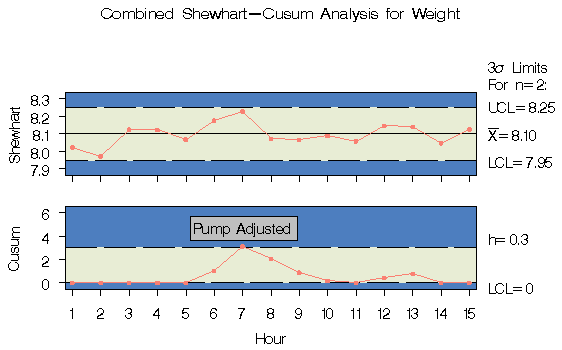Chapter Contents
Previous
Next
|
Chapter Contents |
Previous |
Next |
| XCHART Statement |
| See CUSCOMB in the SAS/QC Sample Library |
Lucas (1982) introduced a combined Shewhart-cusum scheme that is illustrated in this example. Also refer to Ryan (1989). The data set used here is CANS, which is created in "Creating a One-Sided Cusum Chart with a Decision Interval" .
The first step is to compute and save one-sided cusums to detect
a positive shift from the mean.
proc cusum data=cans;
xchart weight*hour /
nochart
mu0 = 8.100 /* target mean */
sigma0 = 0.050 /* known standard deviation */
delta = 1 /* shift to be detected */
h = 3 /* decision interval */
k = 0.5 /* reference value */
scheme = onesided /* onesided scheme */
outtable = tabcus /* save the result} */
( drop = _var_ _subn_ _exlim_
rename = ( _cusum_ = _subr_ _h_ = _uclr_ ) )
;
run;
Note that a headstart value is not used here but can be specified with the HSTART= option. Several variables in the OUTTABLE= data set are dropped or renamed so that they can later be read by the SHEWHART procedure.
The next step is to construct a Shewhart chart (not shown) for
individual measurements.
proc shewhart data=cans;
irchart weight*hour /
nochart
mu0 = 8.100
sigma0 = 0.050
outtable = tabx
( drop = _subr_ _lclr_ _r_ _uclr_ );
id comment;
run;
By default, ![]() limits are computed, but the multiple
of
limits are computed, but the multiple
of ![]() can be modified with the SIGMAS= option.
As before, the results are saved in an OUTTABLE= data set.
can be modified with the SIGMAS= option.
As before, the results are saved in an OUTTABLE= data set.
Next, the two OUTTABLE= data sets are merged.
data combine;
merge tabx tabcus; by hour;
_lclr_ = 0.0;
_r_ = 0.5 * _uclr_;
run;
The data set COMBINE has the structure required for a TABLE= data set used with the IRCHART statement in the SHEWHART procedure (see "TABLE= Data Set" in Chapter 34, "IRCHART Statement").
Finally, the combined scheme is displayed with the SHEWHART procedure.
title "Combined Shewhart-Cusum Analysis for Weight";
symbol v=dot c=salmon;
proc shewhart table=combine;
irchart weight*hour /
ypct1 = 50
noctl2
ucllabel2 = 'h=0.3'
outlabel = ( comment )
outlabel2 = ( comment )
cframelab = ligr
cframe = bigb
split = '/'
cinfill = ywh
cconnect = salmon;
label _subi_ = 'Shewhart/Cusum';
run;
The chart is shown in Output 12.3.1.
Output 12.3.1: Combined Shewhart -Cusum Scheme

|
Lucas (1982) tabulates average run lengths for combined
Shewhart-cusum schemes.
The scheme used here has an ARL of 111.1 for ![]() and an ARL of 6.322 for
and an ARL of 6.322 for ![]() .
.
|
Chapter Contents |
Previous |
Next |
Top |
Copyright © 1999 by SAS Institute Inc., Cary, NC, USA. All rights reserved.